 There is a lot of focus on how to accumulate a big nest egg, but possibly even more complicated is how to spend it down. Vanguard Research has released a new whitepaper called From assets to income: A goals-based approach to retirement spending [pdf] (companion article). The three major topics covered are (1) spending rules, (2) portfolio construction, and (3) tax-efficient withdrawal ordering in retirement. This is a long, dense paper covering a lot of ground, so here are my highlights of just the dynamic spending rules.
There is a lot of focus on how to accumulate a big nest egg, but possibly even more complicated is how to spend it down. Vanguard Research has released a new whitepaper called From assets to income: A goals-based approach to retirement spending [pdf] (companion article). The three major topics covered are (1) spending rules, (2) portfolio construction, and (3) tax-efficient withdrawal ordering in retirement. This is a long, dense paper covering a lot of ground, so here are my highlights of just the dynamic spending rules.
The two major competing goals of spending strategies are:
- You want your nest egg last for the rest of your life. Well… yeah. If your portfolio drops 25%, your stress level goes way up.
- You want a consistent level of income. Everyone likes a reliable stream of income, especially if you’re used to a reliable paycheck during your working years. Having income drop by 25% on year can also be quite painful.
One major consideration is your initial, or target portfolio withdrawal rate. Here’s a figure showing how four primary factors can affect this choice: time horizon, asset allocation, flexibility in annual spending, and how certain you want to be that your portfolio won’t be depleted.
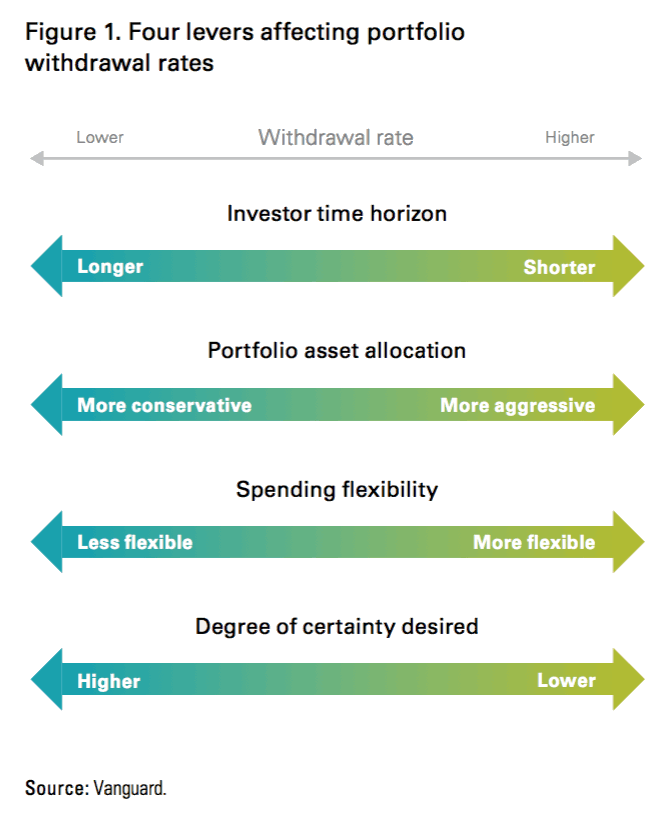
Another major consideration is how to adjust your withdrawal each subsequent year. Vanguard supports a hybrid solution called “dynamic spending” that is a compromise between someone who completely ignores market performance (reliable income most important) and someone who is completely dependent on market performance (portfolio lasting forever most important).
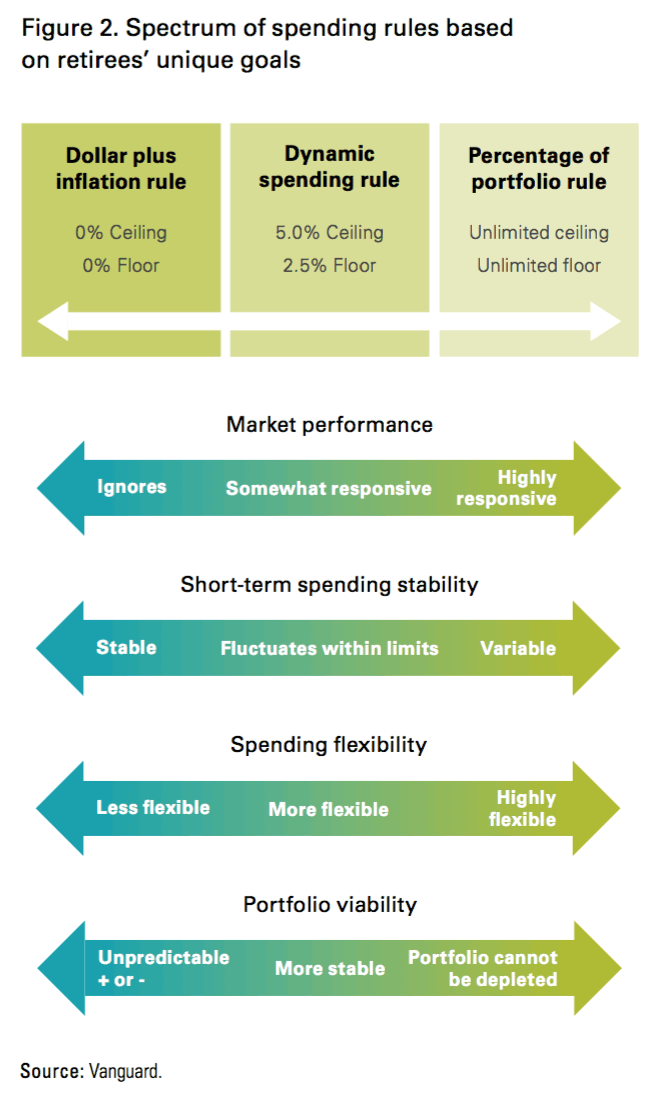
Here’s how dynamic spending works.
- Once a year, multiply your current portfolio balance by your (initial) target portfolio withdrawal rate. This is your unadjusted target spending for the year. For example, $1 million times 5% = $50,000.
- Determine your ceiling (maximum) and floor (minimum) based on last year‘s spending number. For example, you may say that it can only increase by 5% or decrease by 2.5%. If this is your first year, just stick with your existing number.
- Compare the two numbers. If your unadjusted number exceeds the ceiling amount, spend the ceiling. If your unadjusted number is below the floor amount, spend the floor. If unadjusted number is in between, the unadjusted amount becomes your final number.
For example, if last year’s spending was $50,000, then your upper and lower “bumpers” for this year will be $48,750 and $52,500. No matter what the market does, you’ll stay in between these two numbers. You can see a worked-out example using actual numbers in this previous WSJ article.
Your flexibility is rewarded with better portfolio survival odds. Here’s the results of an analysis with the following assumptions: moderate asset allocation of 50% stocks (60% U.S. equity, 40% non-U.S. equity) and 50% bonds (70% U.S. bonds, 30% non-U.S. bonds), a time horizon of 35 years, and initial portfolio withdrawal rate of 5%.
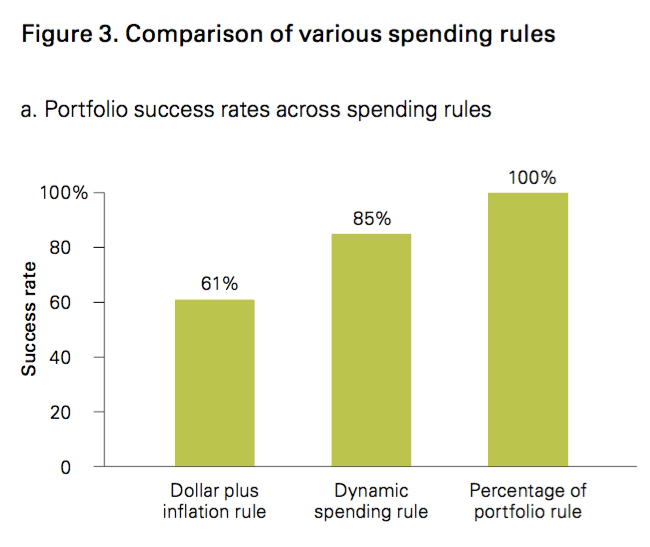
You can see that your portfolio success is improved significantly, even with a relatively high target withdrawal rate of 5%. You can see here that Vanguard picked the 5% ceiling and the 2.5% floor because it provided a portfolio survival rate of 85% over a 35-year time horizon.
Being flexible during periods of poor performance is most important. Vanguard found that a retirees’ ability to accept changes in their floor helps their portfolio more than increasing their ceiling hurts it. Here’s a modified chart from the paper that shows how your portfolio survival rate improves with a lower floor percentage.
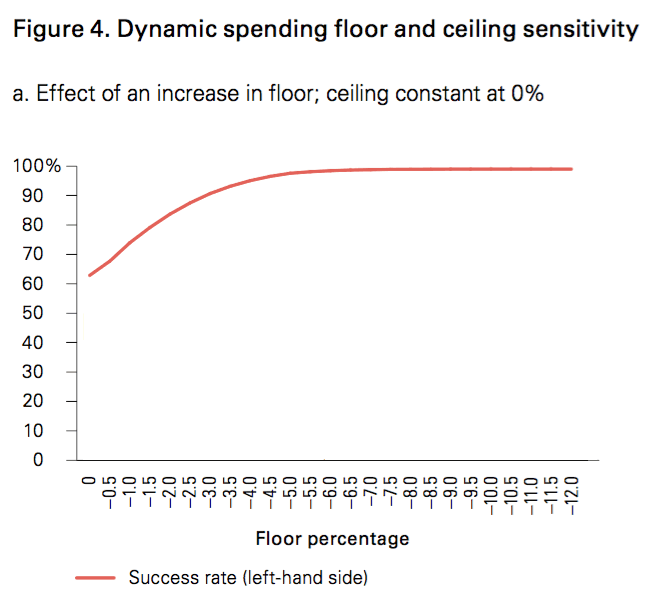
You have to be careful, as having your withdrawals drop 5% a year for 5 straight years might be more than you can handle. You should carefully examine how much flexbility you have in your spending, taking into account other income sources like Social Security. In general, the numbers support Vanguard’s suggestion of a 5% ceiling and 2.5% floor as a good starting point.
Finally, here are some initial/target withdrawals that will get you 85% survival certainty for various time horizons and asset allocations. Click to enlarge. I’d prefer to see some numbers with a 95% survival certainty.
Since my time horizon is (hopefully) closer to 50 years and I want a significantly higher survival certainty, I am personally thinking about a 3% target withdrawal rate combined with a 5% ceiling and 2.5% floor.
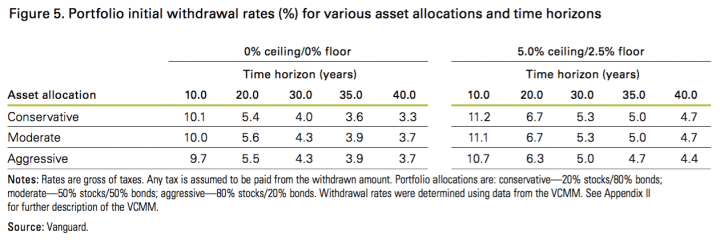
 The Best Credit Card Bonus Offers – 2025
The Best Credit Card Bonus Offers – 2025 Big List of Free Stocks from Brokerage Apps
Big List of Free Stocks from Brokerage Apps Best Interest Rates on Cash - 2025
Best Interest Rates on Cash - 2025 Free Credit Scores x 3 + Free Credit Monitoring
Free Credit Scores x 3 + Free Credit Monitoring Best No Fee 0% APR Balance Transfer Offers
Best No Fee 0% APR Balance Transfer Offers Little-Known Cellular Data Plans That Can Save Big Money
Little-Known Cellular Data Plans That Can Save Big Money How To Haggle Your Cable or Direct TV Bill
How To Haggle Your Cable or Direct TV Bill Big List of Free Consumer Data Reports (Credit, Rent, Work)
Big List of Free Consumer Data Reports (Credit, Rent, Work)
I prefer % of performance rule because that literally allows you to have 100% portfolio survival. Great that VG is putting out these tools now
There is no such thing as 100% of anything for 30 years. You can’t assume anything for that long. Wars, pestilence, asteroid hits, volcanoes, civil unrest, who knows. Nothing is certain, not even you living 30 more years. And even the models assume that returns are ‘no worse than any time in history. The next 30 years may not be anything like ‘any time in history’. Just about all gurus say that planning for 90% is all you need. 95% if you are a nit picker, but anything beyond that is a useless exercise in futility.
This is very insightful. I learned a lot. Thank you for sharing this.